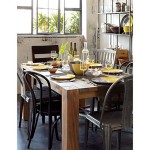Illuminating Elegance: Chandeliers Above Long Dining Room Tables
The dining room serves as a central gathering space within a residence, fostering connection during meals and special occasions. The selection of appropriate lighting plays a pivotal role in establishing the ambiance and functionality of this space. When a long dining room table is present, the choice of a chandelier becomes even more critical, necessitating careful consideration of factors such as size, style, light output, and placement. A well-chosen chandelier can transform a long dining room table from a mere functional surface into a captivating focal point, enhancing the overall dining experience.
The decision-making process regarding a chandelier for a long dining room table demands a holistic approach, evaluating not only aesthetic preferences but also the room's architectural characteristics and functional requirements. This involves assessing the room’s dimensions, ceiling height, and existing décor elements. Furthermore, the intended use of the dining room table, whether for formal dinners, casual family meals, or even as a workspace, significantly influences the optimal chandelier selection.
Key Point 1: Determining the Appropriate Size and Scale
One of the initial and most crucial steps in selecting a chandelier for a long dining room table involves determining the appropriate size and scale. A chandelier that is disproportionately small risks appearing insignificant and failing to provide adequate illumination, while one that is excessively large can overwhelm the space and create a visually unbalanced effect. Several guidelines can assist in making this determination.
A common rule of thumb is to calculate the diameter of the chandelier by adding the length and width of the dining room in feet. The resulting number, expressed in inches, provides a reasonable estimate of the ideal chandelier diameter. For instance, a dining room measuring 12 feet wide and 18 feet long would suggest a chandelier with a diameter of approximately 30 inches. This calculation offers a starting point, which can then be adjusted based on the specific characteristics of the room and the desired aesthetic.
In the case of a long dining room table, the length of the table itself becomes a significant factor in determining the appropriate size and scale of the chandelier. A general recommendation is that the chandelier should be approximately one-half to two-thirds the length of the table. This ensures that the chandelier proportionally complements the table without appearing undersized or dominating the space. For example, a 10-foot long dining room table would ideally accommodate a chandelier ranging from 5 to 6.6 feet in length.
The height of the ceiling also plays a critical role in determining the appropriate height of the chandelier. For standard 8-foot ceilings, a chandelier with a height of 20-24 inches is generally suitable. If the ceiling is higher, the chandelier can be taller to maintain visual balance. A general guideline is to add 3 inches of chandelier height for each additional foot of ceiling height above 8 feet. Therefore, a room with a 10-foot ceiling could accommodate a chandelier with a height of 26-30 inches.
These sizing guidelines are not absolute rules but rather starting points for consideration. Personal preferences, the style of the chandelier, and the overall design aesthetic of the room can all influence the final decision. It is always advisable to visually assess different size options, either through digital renderings or by temporarily placing appropriately sized objects in the space, to determine the most aesthetically pleasing and functionally appropriate choice.
Key Point 2: Exploring Different Styles and Materials
Having established the appropriate size and scale for the chandelier, the next step involves exploring the multitude of styles and materials available. The selected style should complement the existing décor of the dining room and reflect the homeowner's personal taste. The chosen materials should not only align with the design aesthetic but also be durable and easy to maintain.
Traditional chandeliers, often characterized by intricate detailing, ornate designs, and the use of materials such as crystal, wrought iron, and polished brass, evoke a sense of timeless elegance and formality. These chandeliers typically feature multiple tiers of arms adorned with candle-style lights and decorative elements. They are particularly well-suited for formal dining rooms with classic or traditional décor.
Modern chandeliers, on the other hand, embrace clean lines, minimalist designs, and the use of contemporary materials such as stainless steel, glass, and acrylic. These chandeliers often feature geometric shapes, abstract forms, and integrated LED lighting. They are ideal for modern or contemporary dining rooms, adding a touch of sophistication and understated elegance.
Rustic chandeliers, characterized by natural materials such as wood, antlers, and rope, bring a sense of warmth and organic charm to the dining room. These chandeliers often feature distressed finishes, exposed bulbs, and simple, unadorned designs. They are well-suited for rustic, farmhouse, or country-style dining rooms, creating a cozy and inviting atmosphere.
Industrial chandeliers, drawing inspiration from factories and warehouses, feature exposed metal frameworks, Edison-style bulbs, and a raw, utilitarian aesthetic. These chandeliers often incorporate elements such as pipes, chains, and cages. They are ideal for industrial-chic or loft-style dining rooms, adding a touch of edgy sophistication.
Beyond these broad categories, a vast array of other styles and materials are available, including bohemian chandeliers with colorful beads and fringe, transitional chandeliers that blend traditional and modern elements, and custom-designed chandeliers tailored to specific aesthetic preferences. The selection process should involve a thorough exploration of these options, considering the overall design vision for the dining room and the desired ambiance.
The materials used in the chandelier's construction also play a significant role in its appearance and durability. Crystal chandeliers, known for their brilliance and sparkle, add a touch of luxury and formality to the dining room. Metal chandeliers, ranging from wrought iron to stainless steel, offer durability and versatility, complementing a wide range of décor styles. Glass chandeliers, available in various colors and textures, create a soft and diffused light. Wood chandeliers, adding warmth and natural beauty, are ideal for rustic or bohemian-style dining rooms.
Key Point 3: Considerations for Light Output, Placement, and Installation
In addition to size, style, and materials, the light output, placement, and installation of the chandelier are crucial considerations. The chandelier should provide adequate illumination for the dining room table while creating a comfortable and inviting atmosphere. Its placement should ensure even light distribution and avoid glare, and its installation should be performed by a qualified electrician to ensure safety and proper functionality.
The light output of the chandelier is measured in lumens, which indicate the total amount of light emitted. The appropriate lumen output depends on the size of the dining room, the color of the walls and ceiling, and the desired level of brightness. A general guideline is to aim for approximately 20 lumens per square foot of dining room space. Dimmers are also recommended to allow for adjusting the light level to suit different occasions and preferences.
The type of light bulbs used in the chandelier also affects the overall ambiance of the dining room. Incandescent bulbs produce a warm, yellowish light, while LED bulbs offer a wide range of color temperatures, from warm white to cool white. LED bulbs are generally more energy-efficient and long-lasting than incandescent bulbs, although they may be slightly more expensive initially. The choice of light bulb should be made based on the desired color temperature, energy efficiency, and overall aesthetic.
The placement of the chandelier above the long dining room table is critical for ensuring even light distribution and avoiding glare. The chandelier should be centered above the table, typically suspended approximately 30-36 inches above the tabletop for an 8-foot ceiling. For higher ceilings, the chandelier can be hung slightly higher to maintain visual balance. The spacing between the chandelier and the table should be sufficient to allow for comfortable dining without obstructing views or causing glare.
For a particularly long dining room table, considering two or even three smaller chandeliers instead of one very large chandelier can create a more balanced and visually interesting effect. This approach can also provide more even light distribution along the entire length of the table. The chandeliers should be spaced evenly apart, maintaining a consistent distance between them and the edges of the table.
The installation of the chandelier should always be performed by a qualified electrician to ensure safety and compliance with local electrical codes. This involves properly wiring the chandelier, securing it to the ceiling, and testing its functionality. It is essential to disconnect the power supply before commencing any electrical work and to follow all safety precautions. Attempting to install a chandelier without the necessary electrical knowledge and experience can be dangerous and can result in electrical shock or fire.
In summary, selecting a chandelier for a long dining room table involves careful consideration of size, style, materials, light output, placement, and installation. By following these guidelines and consulting with design professionals and qualified electricians, it is possible to choose a chandelier that not only provides adequate illumination but also enhances the aesthetic appeal and functionality of the dining room, creating a welcoming and inviting space for meals and gatherings.

A Guide To Dining Room Chandeliers

20 Dining Rooms With Chic Chandeliers And Pendant Lights

Rectangular Crystal Raindrop Chandelier For Dining Room Sofary Lighting

How High To Hang A Dining Table Chandelier For 10 Foot Ceiling

30 Best Dining Room Light Fixtures Chandelier Pendant Lighting For Ceilings

Lnc Wood Kitchen Chandelier 5 Light Li Farmhouse Black Island Dining Room Pendant With Rustic Rectangle Frame Nzefi2hd13529a6

17 Beautiful Dining Room Chandeliers The Turquoise Home

How High To Hang A Dining Room Chandelier

How To Choose The Perfect Dining Room Light Fixture Graham S Living

4 Light Modern Rectangle Crystal Chandelier Gold Pendant Kitchen Dining Room Homary








